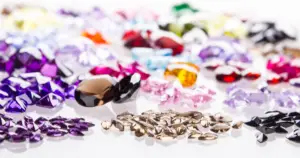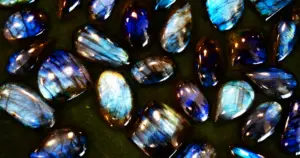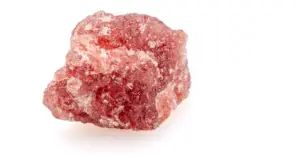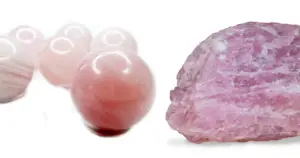Moldavite Fake Vs Real: A Caution
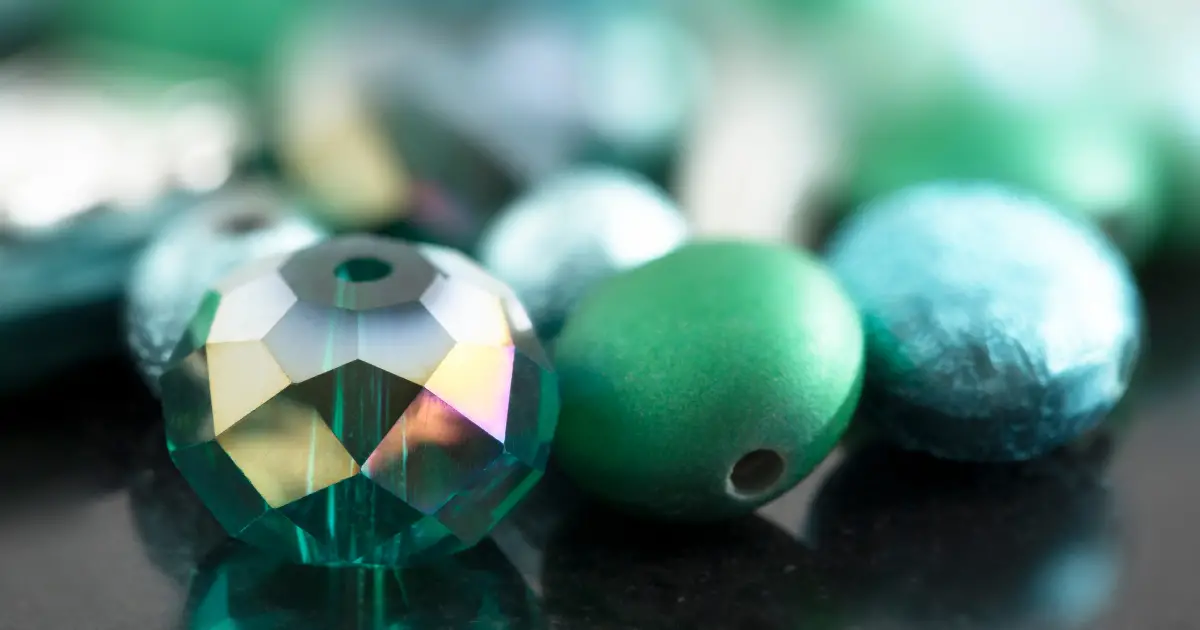
Most people wonder are Moldavite beads real at all due to their uniqueness. Well, Moldavite is the only gemstone-quality tektite found on the planet and it is pretty much real. However, one must always look out for fake Moldavites that are available at an equally higher price. In this article, we will also tell you how to distinguish between Moldavite fake vs real.
Table of Contents
What is Moldavite?
Moldavite is a type of glass formed due to a meteorite impact. It is known as tektite or impact glass and comes primarily from the Nordlinger Ries crater in central and eastern Europe.
It mainly came into existence, when the meteor hit the Earth’s surface creating a debris field that combined meteorites and terrestrial rock that ejected hundreds of miles from the impact site. More than 90% of all Moldavite comes from a handful of places in the Southern Bohemia region, including the Moldau River Valley. The rest come from neighboring countries where their domains are present.
The primary color of Moldavite is a dark olive green, but it is also present in lighter shades ranging from the shade of green-blue known as poison green. There may also be streaks of color that appear brown. Moldavite has a Mohs hardness ranging from 5.5 to 7, a hardness shared by the glass produced. It has the chemical formula SiO2(+AI2O3).
Moldavites got their name from the Vitava River in what is now the Czech Republic. Moldavite was discovered by a German doctor named Josef Mayer who was working as a professor at Charles University in Prague towards the end of the 17th century.
Are Moldavite Beads Real?
Yes, Moldavite is very much real. When a meteor impacted a region on Earth, it gave rise to Moldavite. Collectors highly price it due to its distinctive color and shape. The spiritual therapists also value Moldavite for its energetic properties. However, one must remember that Moldavite formed 15 million years ago when a meteorite struck the planet in the southeast region of modern Germany, Austria, and the Czech Republic.
People use it as jewelry in its natural state as faceted gemstones and beads. The continued popularity and anticipated scarcity of Moldavite have resulted in large fake versions hitting the market. This article will detail the real Moldavite and how you can tell the difference between real and fake.
What does Real Moldavite do?
Moldvate is popular with wire wrappers for making necklaces in their natural state. As mentioned earlier, the metaphysical community seeks Moldavite in its natural state or as part of jewelry to store or wear for its supposed energetic properties.
What is the Origin of the Moldavite Stone?
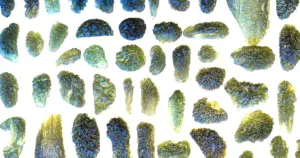
It is necessary to know the origin of Moldavite before starting. Moldavite is the product of a Meteorite collision with Earth about 14.8 million years ago. Known locally as Vltavín, Moldavite is found only in the Moldau River valley of the Czech Republic, roughly 40 square miles. Therefore, you may wonder how you can be sure of the stone’s origin, as a false certificate of authenticity accompanies many counterfeit stones.
Internet imitations of Moldavite from Asia flood Moldavite’s market, but people also sell counterfeit Moldavite in Europe. It is relatively rare to come across counterfeit works sold by private persons who have been duped and are attempting to recoup their losses.
Investigating the dealer’s background and verifiable evaluations from previous customers and clients will provide you with the most precious fee – the truth. Many sellers believe their Moldavite stocks are genuine since this gem is so rare, and some replicas can be convincing. However, there are ways to distinguish genuine Moldavite stones from fake ones.
Moldavite Fake vs Real: A Caution
-
Moldavite Fake vs Real: What Is Fake Moldavite?
Fake or synthetic Moldavite looks very similar to the real thing, except it comes from fabricated glass poured into molds. The dyes mimic the actual Moldavite color, making it difficult for casual viewers to distinguish them.
Manufacturers of fake Moldavite also use colors that are not in real Moldavite. A search of popular websites that don’t review their vendors will return listings of Moldavite in red, pink, yellow, and blue. Moldavite, emerald or bottle green and clears the eye, is most likely made from green glass bottles.
Fake Moldavite can never perfectly mimic the real thing, but that doesn’t deter manufacturers from their production efforts. The biggest tell of fake Moldavite other than familiar shape and color is that fakes contain no inclusions and have little or no bubbles. Moldavite beads have a uniform, crystal clear, and clean appearance. Authentic Moldavite pieces look dirty in comparison.
-
Moldavite Fake vs Real: How to Identify?
There is little similarity between natural and imitation Moldavite other than the glass. True Moldavite includes inclusions and bubbles as a result of its production.
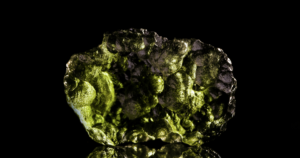
Fake Moldavite has bubbles, although not nearly as many as real Moldavite, and bubbles can be seen on the surface, which is uncommon in actual Moldavite. A false specimen prevents bubble development (bubbles can break the glass when cooled in an oven), but a catastrophic occurrence generated the actual Moldavite.
There are several ways to differentiate between real and fake Moldavite, from superficial knowledge to touching and using a flashlight. Each technique can quickly inform you of the authenticity of your viewing piece.
Moldavite has changed millions of years since its formation in terms of its physical characteristics. Authentic Moldavite will always have a worn, dusty, or dirty look from spending thousands of years underground. Faux Moldavite cannot mimic this look and always looks wet or shiny. Real Moldavite is shiny only when shattered, and even then, only the broken ends of the piece are shiny.
Authentic Moldavite pieces help create molds to make fakes. These patterns can be reduced or enlarged in size but retain the original shape, ridges, waves, and original pattern. Moreover, it’s not unusual to find multiple sizes of Moldavite with the same look.
Counterfeit Moldavite manufacturers repeatedly use the same molds and flood the market with their imitations. You can quickly notice that the same shapes are on sale online and at shows.
Due to the nature of its creation, inclusions are typical in Moldavite. It is normal to see bubble strips or wires inside a Moldavite piece. These inclusions are sometimes apparent to the human eye and contribute to the overall aesthetic of the stone. However, it is pretty uncommon for an apparent item to require the use of a jeweler’s loupe, flashlight, or magnifying glass to discover inclusions and bubbles.
-
Moldavite Fake vs Real: Visual Differences
True Moldavite is known for its olive green color that ranges from pale and translucent to various shades of deep forest green and possible brown streaks. Gas bubbles are often trapped during the formation of Moldavite. These bubbles are an excellent indicator of real Moldavite.
One must consider the size of the piece, as many fake Moldavite pieces can be bargained to lower prices that sound too good to be true. Many fake pieces of Moldavite have a glossy glass-like surface because they are masterpieces of carefully molded molten glass, and sometimes the seams of the mold are easily visible.
Watch out for anyone selling Moldavite that isn’t from the Czech Republic, not even green. Many vendors market other stones as Moldavite to capitalize on its popularity. “White Moldavite” is generally nothing more than Calcite. A true Tektite is more like sea glass than African Moldavite.
-
Moldavite Fake vs Real: Why is there a Fake Moldavite?
Moldavite from Bohemia, South Bohemia, and Moravia is the finest. Most mining sites are closed, with only four mines still today. These mines have a ten-year supply of Moldavite, and when they run dry, there will be no high-quality Moldavite available.
This potential shortage inflated the cost of Moldavite, which encouraged counterfeiters to manufacture counterfeit items to profit from the carelessness.
-
Moldavite Fake vs Real: Where does Fake Moldavite come from?
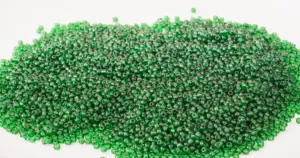
The fakest Moldavite comes from China and India. Some east Asian countries also produce fake Moldavite, but most of the parts on the market come from these two countries. It is most likely fake if you come across an item from countries outside the Czech Republic.
Healing Properties of Moldavite
Moldavite is very popular in metaphysical and healing crystal circles and is known as a stone of transformation, an accelerator of spiritual awakening and personal evolution.
Moldavite is most active with the heart chakra because of its green color, but the power of this stone can activate and open all chakras and enhance any spiritual pursuit. Moldavite is a catalyst for powerful transformation.
While some stones, such as rose quartz, are soothing and nourishing, Moldavite can powerfully change your life and propel you on your highest path to spiritual growth.
It would help if you prepare yourself to confront your shadow self, become conscious of your unconscious motivations and beliefs, and review the lies you tell yourself. Moldavite brings the clear light of awareness to the darkest corners of your mind and fills them with light and love so you can purify them and recover energy for you to use for your highest good.
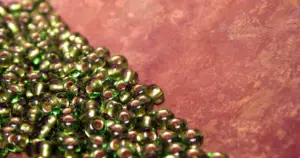
Moldavite is the appropriate crystal ally if you’re stopped in your growth process and don’t know what to do to go forward. What are Moldavite crystals, read here in detail.
Everyone defines “spiritual experience” differently, although most individuals want an enlarged understanding of All That Is. Moldavite can open psychic pathways and take you on a cosmic voyage that will open your eyes to what is genuinely existing in other realms of reality. Moldavite can enhance attempts to communicate with the “other party,” whether contacting your spirit guides or deceased relatives. For this reason, it is a favorite of psychics and psychics, as well as people doing dream work.
Conclusion
Moldavite is typically a deeper green with moss or olive undertones. It generally has a matte finish rather than glossy, slick, or moist. It can have a variety of textures ranging from smooth to rough and wavy, even on the same piece. Moreover, Moldavite has inclusions beneath the surface and swirls and bubbles.
